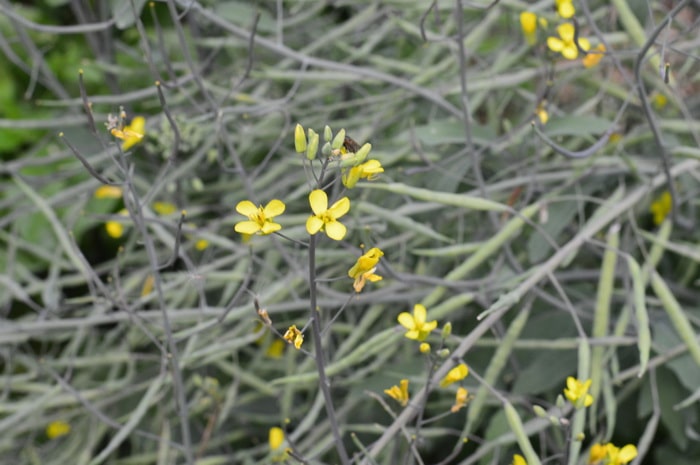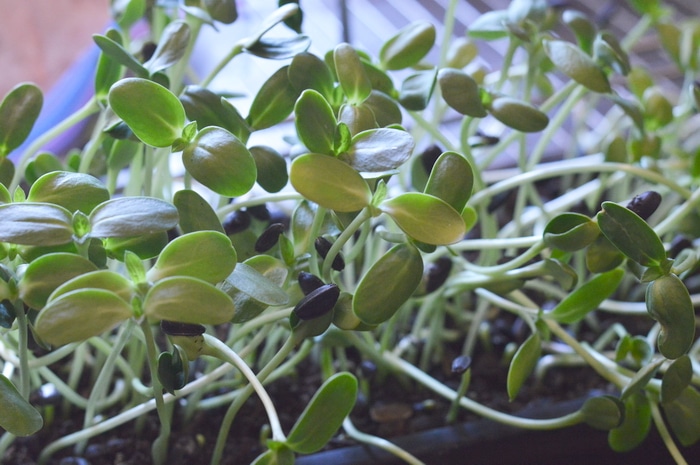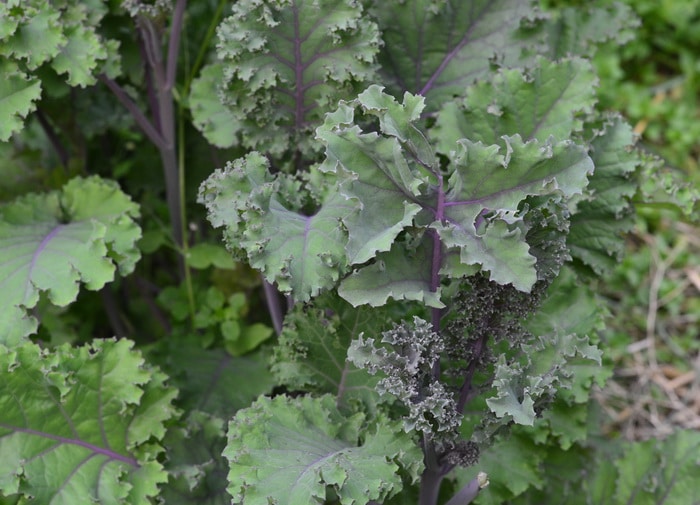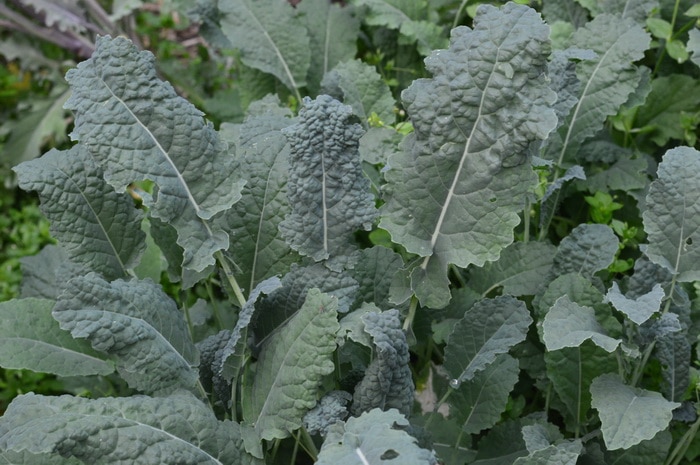You can grow kale year-round almost anywhere and begin harvesting the leaves for salads and snacks just 50 days after planting. New leaves grow all summer as you continue to harvest and it will last until snow cover.
Kale is so easy to grow that I can even grow it here, in zone 3, and even if we have a frosty summer. It is my vegetable garden workhorse, almost nothing phases it. We treat is as a perennial in the garden and as soon as the Spring thaw comes in March it regrows and sends up broccoli like shoots. These fresh baby leaves are awesome in salads.
Kale has 38% protein and is used in the UK as animal fodder, so if you have livestock, grow some for them, too. Rabbits love it, especially at kindling time. It is rich in calcium, phosphorous, magnesium, selenium. vitamin C and has several B vitamins. High in fiber and low in fat, its the perfect snack food.
A History of Kale
This cabbage-like plant is a native of the eastern Mediterranean or Aisa Minor and has been cultivated for so long that its true origin is not known.
Kale is basically a leafy, non-heading cabbage that has retained its shape and place in our diet for thousands of years. Its Latin name says it all – Brassica oleracea – meaning “without a head.”
Russian kale was introduced into Canada, and then into the United States, by Russian traders in the 19th century. USDA botanist David Fairchild is credited with introducing kale (and many other crops) to Americans, having brought it back from Croatia. [source]
Kale Growing Conditions
This member of the Cruciferae family is a biennial that will send up seed stalks in June, which mature here in zone 3 in August or early September.
- Germination time: 6 to 10 days
- Germination Temp: 5C to 22C
- Approx # seeds per ounce: 7000
- Yield per plant: 1 to 2 pounds of leaves
- Estimated time between sowing and first picking: 7 to 12 weeks
Like all cool weather cole crops, kale likes moderately rich soil with plenty of organic matter to help retain soil moisture. The seed will last up to 7 years and 4 plants will give you a huge amount of seed so you can share some with friends. Plan to grow the plant out for seeds every 4 years and you’ll be set for life.

kale flowering in the garden
Sprouting directions
Kale seeds can be sprouted all winter in a jar on your kitchen counter. They add crunch and zest to your winter meals, making kale the easiest vegetable in the world to grow.
Using the glass jar method, this process will take 3 to 5 days to grow the sprouts to 1 to 2 inches long. Leave in indirect light for the last day to green the sprouts. One tablespoon will yield approximately 2 cups of sprouts.
Supplies for sprouting:
- A wide mouth glass jar with a screw ring lid.
- A way to cap the seeds for draining. You can use a piece of muslin or bridal tulle fabric or these stainless steel sprouting lids with an easel to aid drainage for the jar.
- Seeds to sprout – try mixed seeds or a seed sampler assortment
- Fresh, potable water
Step 1: Take the fabric and trace a circle using the jar’s screw ring as a pattern. Cut out the circle. If you’re using the tulle fabric cut two circles for each jar and stitch them together for stability. The screen should fit inside the ring and be flat — so trim as necessary to get a good fit. Make one for each jar, and a few extra.
Step 2: Put 2 tbsp. of seeds for sprouting into a jar. Cover seeds up to 1 inch over the top of the seeds with water. Place screen inside the canning jar ring. Screw the ring on the jar.
Step 3: Allow seeds to soak for 6 to 10 hours. Drain. Don’t leave them longer than this as they will become starved for oxygen.
Step 4: Rinse the seeds in fresh water. Turn jar onto drain board to fully drain. Repeat this step 3 times daily about 8 hours apart.
Step 5: Some seeds will be ready in 3 days, in a warm climate. In a cooler climate or in winter your sprouts may take a week. Once your sprouts are ready to eat, rinse well, drain, and store in a glass jar with a snap lid, in the fridge.

Outdoor Kale Crop Care
Kale is a heavy feeder and for the best crop production, it needs supplemental fertilizer. Use manure tea or another high-nitrogen fertilizer every two to four weeks.
Mulch can be beneficial because it helps to keep the surface of the soil and the roots cool. It also allows feeder roots to absorb soil near the surface. Be sure to keep the mulch 1 to 2 inches away from the stem to lessen the possibility of stem rot.
Remove the mulch in the winter to reduce mouse damage; they are attracted to the warm bed that the mulch creates.
After frost in the Fall, the starches in Kale turned to sugar and the colour deepens, to help the plant cope with the stress of freezing. If you grow your own, you can take advantage of this trait and wait for a few touches of frost before harvesting for drying or making Kale Chips. If you buy your Kale in the grocery store or at the Farmer’s Market, you will miss out on this delicious change of taste, so I encourage you to plant some in a pot on your balcony if you live in the city.

Scarlet Kale
Kale Varieties
I grow Red Russian Kale, a heritage variety, with oak-leafed shaped leaves that turn purple when the leaves have been exposed to frost. Other varieties include:
- Siberian Kale (ruffled green leafed), has curly green leaves for baby leaf and bunching. Tender blue-green leaves with a mildly sweet flavor. The plants are tall, vigorous, and high yielding.
- Blue Curled Scotch Kale (a curly leafed variety) is a compact plant with crinkled leaves. Very cold hardy.
- Red Winter Kale is an heirloom with dark green, oak-shaped leaves and red veins. A very tender variety.
- Thousand Head Kale, usually grown for animal fodder. You can see pictures of many heritage Kale varieties at West Coast Seeds. You’ll be amazed at the different colours and textures offered by this easy to grow vegetable.
- Hanover Salad Kale matures in 30 days and is fast growing. These large smooth leaves are used fresh or steamed like spinach.
- Lacinato (aka Tuscan Kale) is an heirloom variety that has a lovely blue-green leaf with shades of purple. It is winter hardy to -6F.
- Georgia Southern (Creole) Kale is a pre 880 heirloom that works well for Southern or Northern gardens. A real producer with huge, tasty leaves.
Purchase kale seeds at your local nursery, or online at Baker Creek Seeds, Territorial Seeds, Pinetree Garden Seeds, or Richter’s Herbs.
Get more ideas from the book Greens Glorious Greens: More than 140 Ways to Prepare All Those Great-Tasting, Super-Healthy, Beautiful Leafy Greens by Johnna Albi.

Lacinato Kale
What is your favorite way to eat Kale? Share it in the comments section.
Related Articles on Joybilee Farm
How to Save Money Buying Vegetable Seeds for Future Garden Abundance
How to Grow Rhubarb for a Perpetual Harvest That Lasts for Decades
15 Easy Steps to Start Seeds the Right Way and the Secret Sauce For Stronger Plants




I love lacinato and red kale myself. This is a fabulous staple crop for us because we also use it for winter ground cover. So cold hardy! And we’ve learned to make the cheap version of the super-expensive-when-store-bought kale chips. Easy peasy! Good to know the seeds will last up to 7 years.